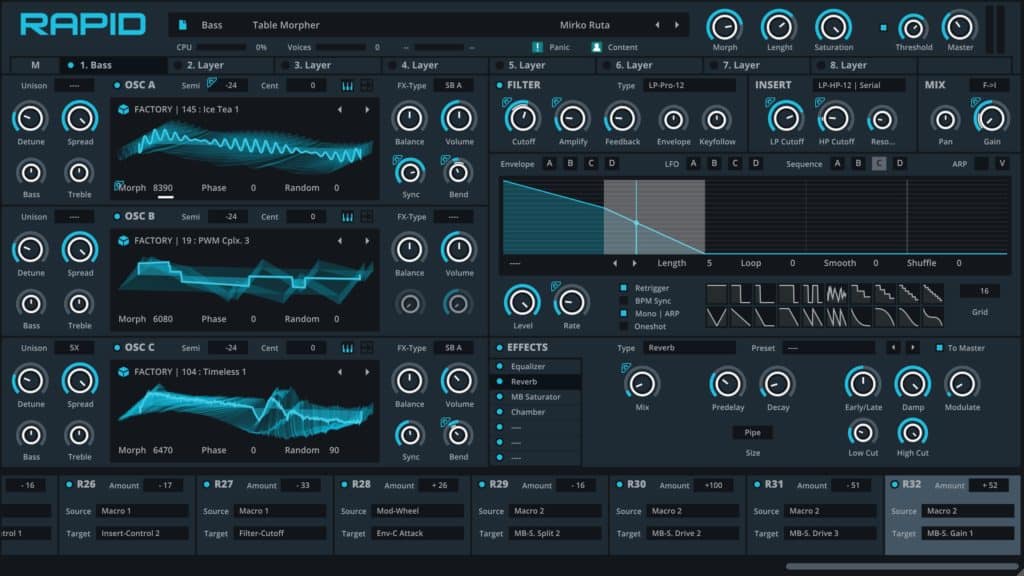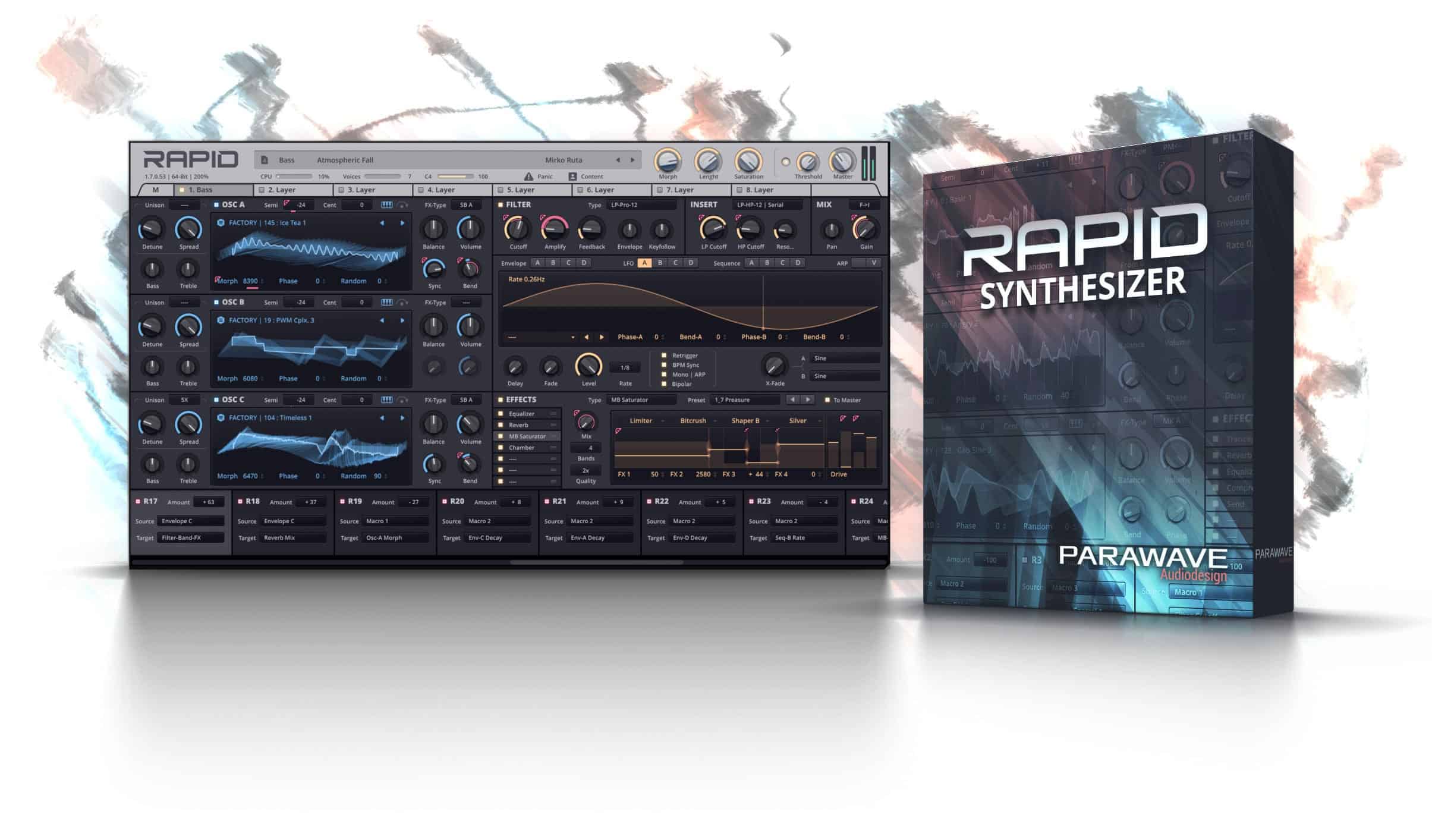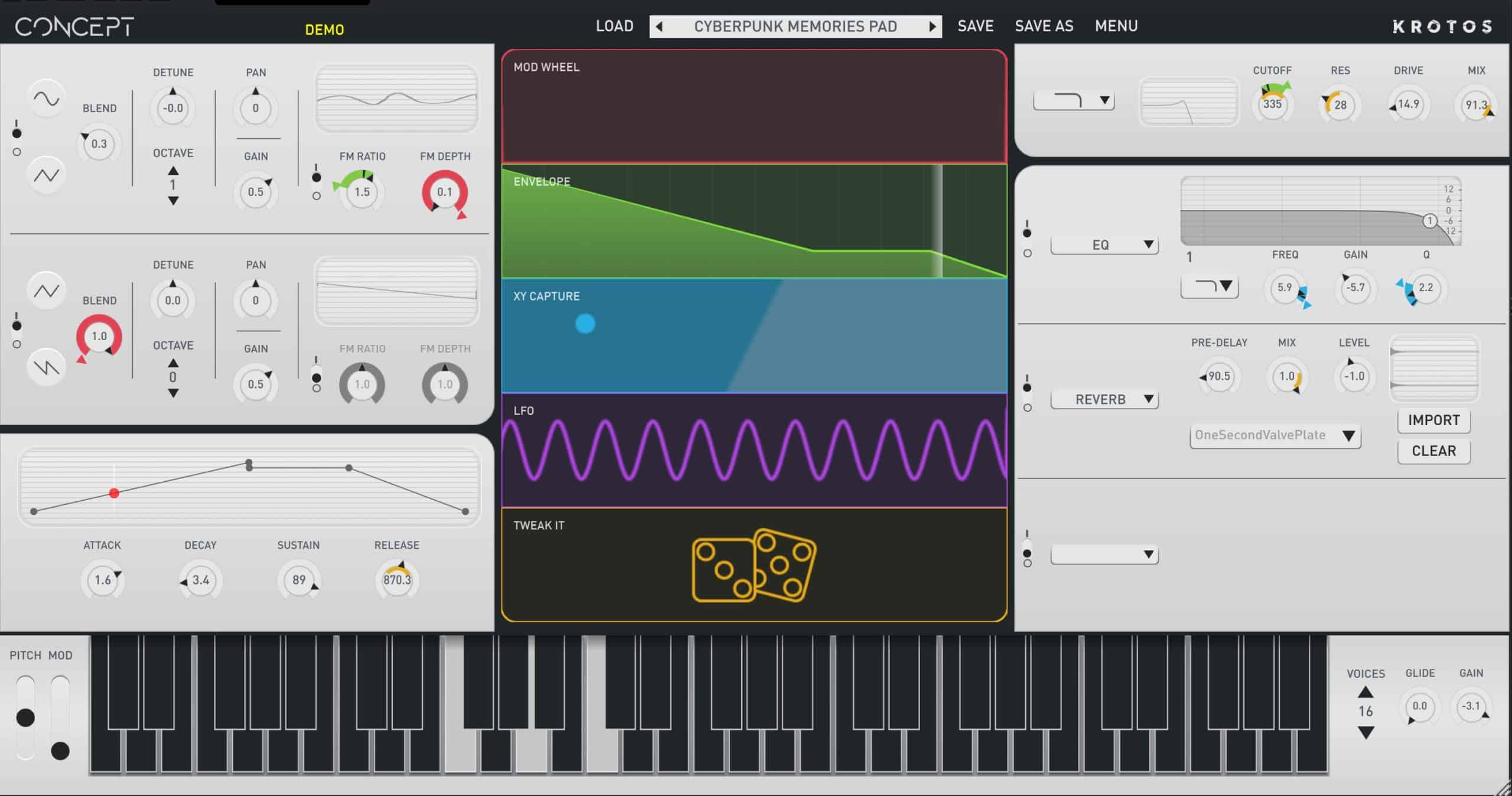Since the last 1.6.x updates in December 2018 Parawave Audio released with version 1.7 new crucial features to the Rapid synthesizer. With the latest version 1.7.0. the additional plugin RAPID FX is available to customers. This effect plugin allows you the use as an effect unit on DAW mixer, insert and send channels and opens up a whole new dimension of sound processing possibilities.
The new updates focus on an enhanced look and feel, the new effect plugin feature for your DAW, three low-pass filters, enhanced reverb effect, and added presets.

New RAPID Version – 1.7.0
- A NEW LOOK – The version added a new main theme and improve the overall visual style.
- INSERT POWER – There are three new oscillator insert effects. The new synchronization bends combine hard sync and phase bending to achieve some interesting and complex wave manipulations. The drift insert adds a randomized organic behavior to each unison voice, ideal for analog emulation and vintage patches. It’s comparable to the heat dependent properties of the analog components and adds small inaccuracies to add unique characteristics.
- FILTER WIZARDRY – There are three new lowpass filters (Pro LP 12dB, Pro LP 24dB, Xtreme LP II). The designs of these filters are based on analog architectures and implement a more intricate feedback drive and resonance behavior.
- REVERB MAGIC – The new models extend the existing reverb by adding a new internal early and late reflection model and smooth the spectral impulse and frequency decay. They simulate different space sizes from small (Nuclear) to very large (Space).
- RAPID FX – It’s now possible to use Rapid as an effect plugin. The FX (Effect) version of Rapid is an additional plugin and already included in the new setup. It will be installed alongside the normal Rapid Synthesizer plugin. You may have to re-scan your plugin list/database.
- FX PRESETS – The new version added a basic set of 93 FX presets. You can find them in the preset browser, mostly named with the prefix FX. e.g. “FX Ambiance” includes some reverb effects. Definitely try out the macros of these presets, they can easily add very complex motion to your mixer track and are ideally suited for build-ups, drops, and other track highlights.
1.7.0 – 29. October 2019 Detailed Features List
Additions:
- New oscillator inserts effect: Sync Bend A & B.
- New oscillator inserts effect: Organic Drift.
- New filter: Lowpass-Pro 12dB and 24dB.
- New filter: Xtreme Lowpass II.
- New insert: Attack Booster.
- New insert: Lowpass Highpass 12dB. Serial & Parallel.
- New Reverb models: Nuclear, Solar, Nova, and Space.
- New Talker FX formant modes “Mate”, “Babe” and “Daft”.
- Modulation targets now show an icon in the top left corner when routed.
- The routing amount is now directly settable from the corresponding target knob.
- Solo layers. Right-click the layer button LED to toggle solo states. Holding Command-key (CTRL) to un-solo all.
- BPM synced rates in modulators and other modules are now routable as a target.
- The oscillator context menu now contains a reset function.
- New Option: One-Click loading of sound presets within the preset browser.
- Quickly change dropdown parameters with Command-key (CTRL) plus Left- or Right-click to select the previous or next parameter value.
Changes:
- Increased modulation value interpolation accuracy.
- Increased sub-buffer midi offset accuracy.
- Smoother UI parameter change interpolation.
- Voice stealing now has an immediate effect on active voices according to the voice limit.
- Improved voice stealing heuristic, so oldest voices are robbed first.
- Arpeggiator timing is now modulatable.
- If a routing entry gets in focus, the position is now always in a visible area.
- Reordered context menu entries in the routing target selection.
- Additional DC Filter on Glitch declick values greater than 50%.
- Increased layer name character maximum to 10.
Fixes:
- Very high MIDI mode arpeggiator loops used an invalid note index.
- MIDI note events are now cleared when switching from a preset with MIDI data to one without.
- MB Saturator. Corrected per band ring modulator phases.
- Moving the sequence loop point now avoids unpredictable jumps.
- When changing BPM synced rates in modulators the index now continues at the correct position.
- Sequences now begin at the start of each step when using a mode with a random phase.
- The arpeggiator phase in UI now shows a more precise shuffle timing.
- Arpeggiator MIDI note-off events at the end of the sequence, on rare occasions, were not triggered correctly.
- Improved monophonic voice mode. Phases and envelopes now continue smoothly when retriggering a note.
- Improved fade out of robbed voice release state when the voice limit is reached.
- After reloading, Ensemble FX damping was only updated when changing the knob value.
- Time-based effect interpolations are now correctly initialized on preset/state change.
Visual:
- Added new “Modern” theme as default.
- Replaced and unified all fonts.
- Moved master compressor display up and band control knobs down.
- Changed layout of master modifiers.
- Added beat markers to trance gate display.
- Arpeggiator note tooltip shows note key-value and velocity percent.
- Increased frame count of knobs and wheels.
- Polaris and Crimson theme don’t use pattern backgrounds anymore.
- Replaced “Gold” theme with “Titanium”.
- Removed “Paradise” and “Retro” theme.
- Various layout adjustments of knob and label positions.
- Various small pixel enhancement and rounded corners.
- Various color adjustments in different color themes.
- Style Data version changed to 1.7.
Presets:
- 93 Rapid FX Presets.
- 18 Rapid FX Templates.
- 24 Feature Presets.
- 14 Sound Presets.
- 75 Sequences.
- 38 Reverb Presets.
- 17 Dual Delay Presets.
- 17 Saturator Presets.
- 13 Delay Presets.
- 7 Trancegate Presets.









